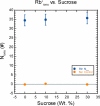Effects of a protecting osmolyte on the ion atmosphere surrounding DNA duplexes
- PMID: 21882885
- PMCID: PMC3500086
- DOI: 10.1021/bi200710m
Effects of a protecting osmolyte on the ion atmosphere surrounding DNA duplexes
Abstract
Osmolytes are small, chemically diverse, organic solutes that function as an essential component of cellular stress response. Protecting osmolytes enhance protein stability via preferential exclusion, and nonprotecting osmolytes, such as urea, destabilize protein structures. Although much is known about osmolyte effects on proteins, less is understood about osmolyte effects on nucleic acids and their counterion atmospheres. Nonprotecting osmolytes destabilize nucleic acid structures, but effects of protecting osmolytes depend on numerous factors including the type of nucleic acid and the complexity of the functional fold. To begin quantifying protecting osmolyte effects on nucleic acid interactions, we used small-angle X-ray scattering (SAXS) techniques to monitor DNA duplexes in the presence of sucrose. This protecting osmolyte is a commonly used contrast matching agent in SAXS studies of protein-nucleic acid complexes; thus, it is important to characterize interaction changes induced by sucrose. Measurements of interactions between duplexes showed no dependence on the presence of up to 30% sucrose, except under high Mg(2+) conditions where stacking interactions were disfavored. The number of excess ions associated with DNA duplexes, reported by anomalous small-angle X-ray scattering (ASAXS) experiments, was sucrose independent. Although protecting osmolytes can destabilize secondary structures, our results suggest that ion atmospheres of individual duplexes remain unperturbed by sucrose.
Figures







Similar articles
-
Osmolyte-driven contraction of a random coil protein.Proc Natl Acad Sci U S A. 1998 Aug 4;95(16):9268-73. doi: 10.1073/pnas.95.16.9268. Proc Natl Acad Sci U S A. 1998. PMID: 9689069 Free PMC article.
-
Using anomalous small angle X-ray scattering to probe the ion atmosphere around nucleic acids.Methods Enzymol. 2009;469:391-410. doi: 10.1016/S0076-6879(09)69019-4. Epub 2009 Nov 17. Methods Enzymol. 2009. PMID: 20946800
-
Osmolyte Effects on Monoclonal Antibody Stability and Concentration-Dependent Protein Interactions with Water and Common Osmolytes.J Phys Chem B. 2016 Apr 7;120(13):3318-30. doi: 10.1021/acs.jpcb.6b00621. Epub 2016 Mar 23. J Phys Chem B. 2016. PMID: 27007711
-
SAXS studies of ion-nucleic acid interactions.Annu Rev Biophys. 2011;40:225-42. doi: 10.1146/annurev-biophys-042910-155349. Annu Rev Biophys. 2011. PMID: 21332357 Review.
-
Single-molecule insights into the temperature and pressure dependent conformational dynamics of nucleic acids in the presence of crowders and osmolytes.Biophys Chem. 2019 Aug;251:106190. doi: 10.1016/j.bpc.2019.106190. Epub 2019 May 23. Biophys Chem. 2019. PMID: 31146215 Review.
Cited by
-
Effects of osmolytes and macromolecular crowders on stable GAAA tetraloops and their preference for a CG closing base pair.PeerJ. 2018 Feb 13;6:e4236. doi: 10.7717/peerj.4236. eCollection 2018. PeerJ. 2018. PMID: 29456882 Free PMC article.
-
Quantitative Studies of an RNA Duplex Electrostatics by Ion Counting.Biophys J. 2019 Sep 17;117(6):1116-1124. doi: 10.1016/j.bpj.2019.08.007. Epub 2019 Aug 12. Biophys J. 2019. PMID: 31466697 Free PMC article.
-
Osmolyte Induced Tumorigenesis and Metastasis: Interactions With Intrinsically Disordered Proteins.Front Oncol. 2018 Aug 28;8:353. doi: 10.3389/fonc.2018.00353. eCollection 2018. Front Oncol. 2018. PMID: 30234016 Free PMC article.
-
Solution structure(s) of trinucleosomes from contrast variation SAXS.Nucleic Acids Res. 2021 May 21;49(9):5028-5037. doi: 10.1093/nar/gkab290. Nucleic Acids Res. 2021. PMID: 34009316 Free PMC article.
-
Local DNA Sequence Controls Asymmetry of DNA Unwrapping from Nucleosome Core Particles.Biophys J. 2018 Sep 4;115(5):773-781. doi: 10.1016/j.bpj.2018.07.009. Epub 2018 Jul 31. Biophys J. 2018. PMID: 30072033 Free PMC article.
References
-
- Yancey PH, Clark ME, Hand SC, Bowlus RD, Somero GN. Living with water stress: evolution of osmolyte systems. Science. 1982;217:1214–1222. - PubMed
-
- Bolen DW. Protein stabilization by naturally occurring osmolytes. Methods Mol Biol. 2001;168:17–36. - PubMed
-
- Yancey PH. Organic osmolytes as compatible, metabolic and counteracting cytoprotectants in high osmolarity and other stresses. J Exp Biol. 2005;208:2819–2830. - PubMed
-
- Timasheff SN. The control of protein stability and association by weak interactions with water: how do solvents affect these processes? Annu Rev Biophys Biomol Struct. 1993;22:67–97. - PubMed
Publication types
MeSH terms
Substances
Grants and funding
LinkOut - more resources
Full Text Sources

